Oxford University Press's Blog, page 453
October 16, 2016
The library – 100 years from now
I want to live to be 100 years old. Yes, that is a bold statement, and I’ll admit this goal may be a bit unrealistic and potentially impossible, but my curiosity pushes me to beat the laws of nature. As a 22-year-old avid reader working for a publishing company, I can’t help but wonder: what will be the future of the printed book? Since the creation of the world wide web by Tim Burners-Lee in 1989 and it’s continual expansion since then, this question has haunted the publishing industry, raising profound questions about the state of the industry and the printed book. After the debut of the Amazon Kindle and the Barnes & Noble Nook, it seemed as if the days of print materials were numbered. Katie Paterson, founder of the Future Library of Norwa project, doesn’t seem to think so, and she’s got a plan to ensure their existence.
A renowned Scottish artist, Paterson is known for her grand-scale artistic ideas and endeavors. On 12 June 12 2014, Paterson began a century-long project as her way of preserving the future of the library and the printed book. Over 1,000 trees have been planted in the Nordmarka forest just outside of Oslo, Norway for the Future Library, called Framtidsbiblioteket in Swedish. These trees, only now just saplings, will grow to full maturity by 2114, ready to be harvested to print the most mysterious literary anthology ever compiled.
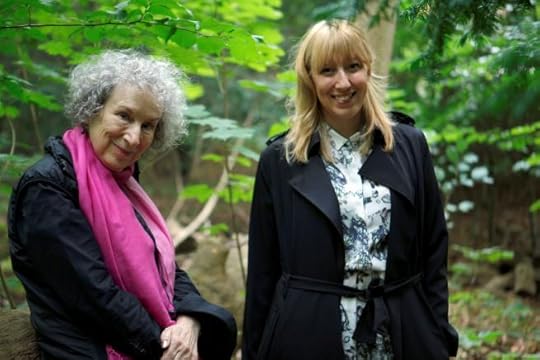 Margaret Atwood and Katie Paterson. Photo © by Giorgia Polizzi. Used with permission via Katie Paterson.
Margaret Atwood and Katie Paterson. Photo © by Giorgia Polizzi. Used with permission via Katie Paterson.Each year, one prominent author submits an original manuscript of his or her writing—be it a poem, short story, novel, play, anything—and seals it in a box. For the next 100 years, that box will be kept in trust, unpublished, until 2114 when the future project leaders will publish the set of works submitted into printed anthologies available to the public. The New Deichmanske Public Library in Bjørvika, Oslo, opens in 2019 and will house the manuscripts in a specially designed room, lined with wood from the forest. Only the authors’ names and titles of their works will be displayed.
For the next 98 years, no one—not even Katie Paterson herself—will be able to read these submissions, and the authors of these works will most likely never experience the public’s reaction to their writings. In fact, most everyone who is currently working on this project with Paterson will never see the results of their efforts, and can only hope that the people to whom they entrust this project will continue their legacy in the ways directed. With hope, their grandchildren might be old enough to purchase a volume of the anthology, but even that’s no guarantee. In a world so consumed with providing a better existence for future generations, how selfless of an endeavor to work on a project the creator will knowingly never be able to enjoy.
Canadian poet, novelist, and literary critic Margaret Atwood inaugurated the project, placing her piece entitled Scribbler Moon into the hands of the chairman of the Future Library in May 2015. Soon to follow was celebrated British author David Mitchell, entrusting his manuscript From Me Flows What You Call Time to the library in May 2016. In a video interview with Mitchell, he describes the project as “an antidote to dystopia.”
 Deichmanske bibliotek / Oslo Public Library, where the manuscripts will be housed. Photo © by Atelier Oslo and Lund Hagem. Used with permission via Katie Paterson.
Deichmanske bibliotek / Oslo Public Library, where the manuscripts will be housed. Photo © by Atelier Oslo and Lund Hagem. Used with permission via Katie Paterson.Mitchell raises a thought-provoking point. In a world so rapidly advancing as ours, with technological feats being accomplished daily, is there any reason to believe that texts will be printed in the future, or that a physical library will house these texts? Will the remnants of a printed past still remain in the digital future? It’s hard to say. But with Paterson’s project, at least there is hope that books will still be printed, bought, and more importantly, read.
The public can now purchase a certificate that guarantees them a printed copy of the final anthology. Your children—or rather your children’s children—can be, in David Mitchell’s words, “a stakeholder in the future,” and one of the first to own an original piece of history, never before seen.
The Future Library announced on Friday, 14 October 2016, that its next contributing author will be Sigurjón Birgir Sigurðsson, more commonly known as Sjón, who will place his unpublished, original manuscript into the hands of Katie Paterson in June 2017. When asked about the project, Sjón commented:
“Like the best of games, the Future Library makes the player aware of the skills and flaws he or she brings to the playing field, in this case it tests the fundamentals of everything an author must deal with when sincerely engaging with the art of writing: Am I a writer of my times? Who do I write for? How much does the response of the reader matter to me? What in a text makes it timeless? And for some of us it poses the hardest question of all: Will there be people in the future who understand the language I write in? It is a game I look forward to play with enthusiasm and earnestness.”
As the new year slowly approaches, my excitement builds, and I will continue to plot my new near-impossible dream of living to be 120 years old so I can finally read that printed anthology.
Featured Image Credit: Katie Paterson, Future Library, 2014-2114 © by MJC. Used with permission via Katie Paterson.
The post The library – 100 years from now appeared first on OUPblog.

A person-less variant of the Bernadete paradox
Before looking at the person-less variant of the Bernadete paradox, lets review the original:
Imagine that Alice is walking towards a point – call it A – and will continue walking past A unless something prevents her from progressing further.
There is also an infinite series of gods, which we shall call G1, G2, G3, and so on. Each god in the series intends to erect a magical barrier preventing Alice from progressing further if Alice reaches a certain point (and each god will do nothing otherwise):
(1) G1 will erect a barrier at exactly ½ meter past A if Alice reaches that point.
(2) G2 will erect a barrier at exactly ¼ meter past A if Alice reaches that point.
(3) G3 will erect a barrier at exactly 1/8 meter past A if Alice reaches that point.
And so on.
Note that the possible barriers get arbitrarily close to A. Now, what happens when Alice approaches A?
Alice’s forward progress will be mysteriously halted at A, but no barriers will have been erected by any of the gods, and so there is no explanation for Alice’s inability to move forward. Proof: Imagine that Alice did travel past A. Then she would have had to go some finite distance past A. But, for any such distance, there is a god far enough along in the list who would have thrown up a barrier before Alice reached that point. So Alice can’t reach that point after all. Thus, Alice has to halt at A. But, since Alice doesn’t travel past A, none of the gods actually do anything.
Some responses to this paradox argue that the Gods have individually consistent, but jointly inconsistent intentions, and hence cannot actually promise to do what they promise to do. Other responses have suggested that the fusion of the individual intentions of the gods, or some similarly complex construction, is what blocks Alice’s path, even though no individual God actually erects a barrier. But it turns out that we can construct a version of the paradox that seems immune to both strategies.
Image that A, B, and C are points lying exactly one meter from the next, in a straight line (in that order). A particle p leaves point A, and begins travelling towards point B at exactly one second before midnight. The particle p is travelling at exactly one meter per second. The particle p will pass through B (at exactly midnight) and continue on towards C unless something prevents it from progressing further.
There is also an infinite series of force-field generators, which we shall call G1, G2, G3, and so on. Each force-field generator in the series will erect an impenetrable force field at a certain point between A and B, and at a certain time. In particular:
(1) G1 will generate a force-field at exactly ½ meter past B at ¼ second past midnight, and take the force-field down at exactly 1 second past midnight.
(2) G2 will generate a force-field at exactly ¼ meter past B at exactly 1/8 second past midnight, and take the force-field down at exactly 1/2 second past midnight.
(3) G3 will generate a force-field at exactly 1/8 meter past B at exactly 1/16 second past midnight, and take the force-field down at exactly 1/4 second past midnight.
And so on. In short, for each natural number n:
(n) Gn will generate a force-field at exactly 1/2n meter past B at exactly 1/2n+1 second past midnight, and take the force-field down at exactly 1/2n-1 second past midnight.
Now, what happens when p approaches B?
Particle p’s forward progress will be mysteriously halted at B, but p will not have impacted any of the barriers, and so there is no explanation for p’s inability to move forward. Proof: Imagine that particle p did travel to some point x past B. Let n be the largest whole number such that 1/2n is less than x. Then p would have travelled at a constant speed between the point ½n+2 meter past B and 1/2n meter past B during the period from ½n+2 second past midnight and 1/2n second past midnight. But there is a force-field at 1/2n+1 meter past B for this entire duration, so p cannot move uniformly from ½n+2 meter past B and 1/2n meter past B during this period. Thus, p is halted at B. But p does not make contact with any of the force-fields, since the distance between the mth force-field and p (when it stops at B) is 1/2m meters, and the mth force-field does not appear until 1/2m+1 second after the particle halts at B.
Notice that since there are no gods (or anyone else) in this version of the puzzle, no solution relying on facts about intentions will apply here. More generally, unlike the original puzzle, in this set-up the force-fields are generated at the appropriate places and times regardless of how the particle behaves – there are no instructions or outcomes that are dependent upon the particle’s behavior. In addition, arguing that, even though no individual force-field stops the particle, the fusion or union of the force-fields does stop the particle will be tricky, since although at any point during the first ½ second after midnight two different force-fields will exist, there is no time at which all of the force-fields exist.
Thanks go to the students in my Fall 2016 Paradoxes and Infinity course for the inspiration for this puzzle!
Image credit: Photo by Nicolas Raymond, CC BY 2.0 via Flickr.
The post A person-less variant of the Bernadete paradox appeared first on OUPblog.

October 15, 2016
The nail that sticks out gets hammered down, or does it?
Do you have a tattoo to care for? If not, shouldn’t you ask yourself, why not? Butterflies on calves, angel wings on shoulders, Celtic crosses across chests of law-abiding citizens have superseded anchors and arrow-pierced hearts on biceps of the demimonde. The size of your body surface area is the limit, because, “YAS, this gives you life!”
Of course, whether or not you pay a scratcher to prick your skin is a purely personal decision; strangely, however, a generation ago no one (dare I say it?) in their right mind took such a decision, whereas now many perfectly normal people do. If you meet someone with crossbones on their sternum you do not avoid them, as your parents would have done; rather you’d ask, with real or fake admiration, who did this kicky job?
I‘m not concerned about the diffusion of bad taste, because chacun à son goût. More interesting is the question why this happens. The craze for ink comes in waves. In the 1880s, the Duke of York, later Kind George V, made tattoos respectable by acquiring one in Japan. In the 20th century, the taste for painful body paintings faded into oblivion, until in the 1990s, it resurfaced, if differently.
The other day, I saw a beautiful blonde with an inscription round her left ankle: The nail that sticks out gets hammered down, it read, in Japanese. Since this is a rather hackneyed Japanese proverb which in the event was lifted out of its native context where tattoos are still strongly associated with organized crime, it was quite funny and ingenious. Most tattoos are more run of the mill, making use of stock elements.
The same with language. How we express ourselves is based on personal decisions. No one speaks like me. My accent, my choice of words, not to mention the volume and velocity of my prattling. Yet, there is nothing more social than language. A private language, as philosophers found out long ago, is an oxymoron. Language lives by serving a community of at least two. Each word I say makes sense only if validated by another speaker willing to recognize my intention. In this sense a language sets limits; limits to freedom of expression.
The community of speakers does not tolerate too much deviance. Our articulations are entirely personal, like the tattoo behind our ear, but there is a strong element of group thinking going on. Language is essentially social. The influence an individual can exercise on it is minimal. We know that even pitch, which seems to be as natural as a finger print and beyond control, is social and changes with time, like fashion.
Reducing something as noble as language to the whims of fashion – isn’t that rather frivolous? It isn’t. Expressions like ‘on fleek’ come in and go out of fashion like tattoos, although they are less painful to remove from your repertoire.
But you can wait for a long time for the beautiful blonde (or handsome prince) to come along and say something imaginative that will enrich the language. Most people say something “entirely unique and personal” – because others do. They flow with the tide, employing language not to be innovative, but for its other important function, to show that they aren’t deviant, but belong to the fold. Language is a very productive tool that enables us to express new ideas and the same ideas over and over again in ever new ways, but only few blonde ladies (and handsome princes) leave their mark on it when they put it to use.
Those who stick out in pathological or otherwise incomprehensible ways get side-lined by not being understood. Only rarely is an individual’s transgressing and bending of the rules accepted as a productive contribution to shaping a language. For the ordinary nail that sticks out gets hammered down, but the silver nail that offers a new hold on things is on ‘fleek’ and revered, in Japan as elsewhere.
Featured image credit: “Dictionary” by jwyg. CC BY 2.0 via Flickr.
The post The nail that sticks out gets hammered down, or does it? appeared first on OUPblog.

Brexit: the UK’s different options
The UK’s vote to leave the EU has resulted in a tremendous amount of uncertainty regarding the UK’s future relationship with the EU. Yet, predicting what type of new relationship the UK will have with the EU and its 27 other Member States post-‘Brexit’ is very difficult, mainly because it is the first time an EU member state prepares to leave. Although much will depend on the upcoming UK-EU negotiations, we can expect either one, or a mixture, of the following options.
European Economic Area (EEA – ‘the Norway model’)
Put simply, being a member of the EEA is almost the same as being a member of the EU; the country has full access to almost all areas of the single market both in goods and in services. One of the main differences is that even though the country needs to comply with the rules of the single market, it does not have any influence over the setting of these rules. EEA countries also need to contribute to the EU budget and have to accept the free movement of people.
European Free Trade Association (EFTA)
Members of EFTA have access to the EU’s single market for goods. They do not need to contribute to the EU budget nor respect the free movement of people. However, EFTA members do not have access to the single market in services. This is a particular disadvantage for the UK due to its economy being heavily dependent on the services sector.
Although much will depend on the upcoming UK-EU negotiations, we can expect either one, or a mixture, of the following options.
Bilateral agreements: the à la carte approach
This option entails negotiating a series of bilateral treaties with the EU, thus choosing which EU initiatives the UK wishes to participate in. The strengths and weaknesses of this option are probably one of the most difficult to predict, since the rules around bilateral agreements with the EU are decided on a case-by-case basis. Whether the UK could have full access to the single market and under what conditions is therefore almost impossible to guess prior to the negotiation. The size of the contribution to the EU budget would also depend on what parts of the EU the UK would want to opt into, for example, the arrangement which Switzerland managed to achieve with the EU after many years of negotiations ( see table below).
A UK-specific deal
Securing a completely new UK-EU trade deal is also possible. Although the options outlined above try to sketch out possible scenarios based on current agreements with non-EU countries, the lack of a precedent could result in the UK (and the EU) being given carte blanche regarding the rules of this new relationship.
A UK-specific deal certainly seems to be what UK Prime Minister Theresa May is seeking since taking office mid-July. Whether or not her 27 counterparts agree with her vision remains to be seen.
No deal: staying a member of the EU
Although unlikely, it remains a possibility that the UK could stay in the EU. Even if May’s government triggers Article 50 in January 2017, the result of the subsequent negotiations (i.e. whatever ‘new deal’ is reached) will need to be legitimised in the UK by another vote of some kind – either by Parliament, a general election, or another referendum. If this new deal is rejected, then the UK would stay a member of the EU. UK public opinion, therefore, has an important role to play in the Brexit vote’s aftermath.
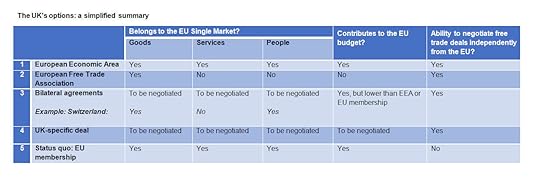 The UK’s options: a simplified summary by Léo Wilkinson. Used with permission.
The UK’s options: a simplified summary by Léo Wilkinson. Used with permission.One of the core areas of contention in the Brexit negotiations is the trade-off between limiting immigration to the UK and keeping free trade with the EU single market. Over the summer, May stated, both in the UK and abroad, that limiting immigration was at the heart of the referendum’s result. Yet the UK has always been a strong supporter of the EU’s single market and retaining access to it is very important for most Conservatives.
However, according to the current EU treaties, the free movement of people goes hand-in-hand with access to the single market since it is one of the EU’s four freedoms: the free movement of goods, services, capital and persons. Shortly after the referendum result, the Presidents of the European Commission, the European Parliament, and the European Council – as well as French President Hollande and German Chancellor Merkel – all stressed that the four freedoms go together and that “cherry-picking” was out of the question.
Moreover, retaining access to the single market for services is very important for the UK; it is a dominant sector of the UK economy contributing around 77% of UK GDP, and the UK is particularly strong in this area compared to other EU countries. Although access to the single market for goods is possible without free movement of people, there is no precedent for the same to apply to services: in previous deals between the EU and non-EU countries, access to the services single market has also required free movement of people. If the EU 27 decide not to make a bespoke deal to the UK due to fears of setting an – attractive – precedent for others, then reaching a compromise on this thorny issue may prove to be very difficult.
This range of different options is likely to make it extremely difficult for the UK Government to prepare its negotiating position while also satisfying the broad-church of ‘Brexiteers.’ Once that is complete and Article 50 is triggered, this ‘divorce’, being a first in the EU’s history, means not only that the negotiations themselves are going to be crucial, but also that their outcome is likely to be unpredictable. As such, Theresa May’s government clearly has a lot of thinking to do this autumn in order for it to “make a success of Brexit.”
Featured image credit: Europe England by Alexas_Fotos. Public domain via Pixabay.
The post Brexit: the UK’s different options appeared first on OUPblog.

Shakespeare’s contemporaries and collaborators [infographic]
While it is obvious that Shakespeare drew a tremendous amount of inspiration from Christopher Marlowe (note the effect of The Jew of Malta, Hero and Leander, and Tamburlaine on The Merchant of Venice, As You Like It, and Shakespeare’s history plays, respectively), this kind of borrowing and collaboration was common during the time. Collaboration was one of the most effective ways for playwrights to generate works quickly and appease the demands of their audiences. Additionally, there was no set principle in regards to a playwright’s “intellectual property,” so copying, borrowing, and referencing other works was common practice. As a result, hundreds of plays written during the late 16th century and early 17th century were collaborative efforts or incorporated the writing of other playwrights.

Download the infographic as a PDF or JPG.
Featured Image: “Shakespeare and His Friends at the Mermaid Tavern” by John Faed. Public Domain via Wikimedia Commons.
The post Shakespeare’s contemporaries and collaborators [infographic] appeared first on OUPblog.

Art in the age of digital production
Between 1986 and 1988, the jazz musician and experimental music pioneer George Lewis created the first version of Voyager. Through encountering the music of David Behrman, Jim Horton and others in the 1970s, Lewis became fascinated with the possibilities afforded by using computers in creating music. After spending some time making work that involved compositional programmes in Paris, Lewis returned to the US and began work on Voyager. His aspiration was not simply to use computers as a tool or raw material, but to create software that could take an equal improvisational role to the other (human) musicians in the performance.
Anyone who listens to Voyager’s improvisational jazz will not have a problem with calling its performances ‘art’. But there remains something unsettling about the ascription. Even today we tend to think of art as a distinctively human creation, arguably one of our highest and defining achievements. But works created by software such as Voyager call that assumption into question, asking us to re-evaluate our understanding of the nature of art, the role of the artist and our relationship to these new technologies.
The phrase ‘computer art’ has taken on varied meanings. Since the rapid expansion of electronic music in the 1970s, computers have taken on a central role in the production, distribution, and reception of music. However, in the case of Voyager the computer isn’t just a tool used to produce or present the work. Nor is it simply playing a composition that has been dictated to it by a composer or mp3 file. Instead, Voyager appears to be an improvising performer like every other musician involved in making the piece, creating and writing the music as the work unfolds. In short, the computer programme has the constitutive role of being a creator of the music.
The view that art is a distinct product of human activity can perhaps be traced back to the Enlightenment period in eighteenth-century Germany. As the philosopher Theodor Adorno noted in his Aesthetic Theory, during this time art began to be recognized as a distinct sphere of value and activity, independent of its relationship to religious practices and state power. Artists were no longer mere craftsmen or the vessels of divine inspiration, instead they came to be seen as ‘geniuses’ whose exceptional mental capacities and talents enabled them to create art. Immanuel Kant, one of the many proponents of this view, claimed that the artist possessed “an inborn predisposition of mind” in which they drew on their imagination, understanding, taste, and “spirit” to create original and exemplary works.
Although the idea of the artist-as-genius has now largely fallen out of favour, many still think of art as a distinctly human creation. One of the main reasons for this is the belief that creating art involves intentional actions and mental states: an artist is someone that creates art by virtue of intending to do so when composing the work. Moreover, artworks often express meanings in a way that other products of human activity don’t. For Oliver Roeder, even computer art is the product of the intention of the artist. The artist, after all, is the one who created the computer system in the first place.
If this is the case, then it would be difficult to think of Voyager as anything like an ‘artist’ or creator of the music it performs. At best, it might be said that Voyager is a tool used by George Lewis to create music. Scientists and programmers have yet to create a computer that has anything like the cognitive states or capacities that are presupposed in intending to do something and certainly the early versions of Voyager, created in the mid-1980s, lack these.
But why should we think that all art must be the product of intention? It is far from clear why we should favour rejecting Voyager as a co-creator of the music, instead of adapting our theories of art and its creation to accommodate it. The idea that art changes over history and requires this to be acknowledged in our theories is hardly anything new. Hegel saw art as something that progressed and developed through human history, just as Walter Benjamin claimed that the birth of photography fundamentally changed the nature of art in modernity. The fact that we now have art produced by computers and call it ‘art’ should equally give us reason to think that it is our theories that are now in need of revision to accommodate it, not our language to exclude it.
This question becomes more pressing with the recent resurgence of computer programmes designed to create their own music, with projects such as Google’s Magenta and Ji-Sung Kim’s Deepjazz being just two examples. Given the status we have ascribed to artistic creation since the Enlightenment, it is hardly surprising that computer scientists are pursuing this goal. It is now certainly true that programmes such as these and Voyager can now create music that is indiscernible from that created by an exceptional human artist.
But the achievement of developing a computer programme that can do this does not mean, as some have concluded, that we are witnessing an age in which there is no longer any real difference between ‘human art’ and ‘computer art’. Instead, that distinction has become essential to understanding what art is and why it matters today. Voyager raises questions about the nature of art, and its relationship to humanity, that could not have been asked before its emergence. As George Lewis once said: ‘Rather than asking if computers can be creative and intelligent… Voyager asks us where our own creativity and intelligence might lie—not “How do we create intelligence?” but “How do we find it?”
Featured image: Computer Code by Markus Spiske. CC0 via Unsplash.
The post Art in the age of digital production appeared first on OUPblog.

October 14, 2016
Beyond business and the book fair: exploring Frankfurt
The world’s biggest book fair is opening its doors soon and, as a native “Frankfurter” working in the publishing industry, it’s the time of year that my colleagues start asking me about my hometown. Sadly, the most common thing I hear is that there is little that they know beyond Frankfurt airport and the exhibition centre.
So for those who return to Frankfurt book fair year after year, I hope to inspire you get out and explore my beautiful native city!
Frankfurt city centre – viewpoints and museums:
The first and most obvious sight when heading into Frankfurt is the city’s skyline, and many heads turn towards the skyscrapers when arriving. Why not take a ride up to the Main Tower viewing platform or its restaurant for a bird’s eye view? Picturesque sights of the city can also be enjoyed from Eiserner Steg. This bridge close to the “Römer,” the town square, leads across the River Main and is at one end of Frankfurt’s museum embankment. This is home to the famous Städel, a prominent fine art museum, the German Film Museum, and the German Architecture Museum, as well as other renowned museums.
On the opposite side of the river, right by the“Römer,” is Schirn Kunsthalle Frankfurt. This hosts visiting art exhibitions and right next to it you’ll find the historic “Dom,” Frankfurt’s cathedral, which is well worth a visit, too.
An oasis in the city – “Palmengarten” and “Holzhausenschlösschen”:
If you’re looking for a breath of fresh air, you may prefer to head north-west of the city centre, where the “Palmengarten” (literally “palm garden”) lies, with its fascinating big greenhouses, beautiful water–lily pond, and lush vast grounds. You can spend hours there or simply enjoy a coffee in its lovely on-site café. Also quite central, slightly north of the centre, is the charming and historic “Holzhausenschlösschen,” a pretty baroque style water-moat castle. Both “Palmengarten” and “Holzhausenschlösschen,” offer an extensive cultural programme in the form of concerts, exhibitions and readings in their appealing settings.
 Frankfurt Town Centre. Image credit: Frankfurt Town Centre. CC0 Public Domain via Pixabay.
Frankfurt Town Centre. Image credit: Frankfurt Town Centre. CC0 Public Domain via Pixabay.Another way of finding some peace and quiet could be to simply take a stroll along the River Main. The centrally accessible riverside allows you to get away from the hustle and bustle of the city and find a more serene spot with a great view across the water to the skyline beyond. Alternatively, Frankfurt has many cafés, “Konditors” (the German equivalent of a “Patisserie”), ice cream parlours and bakeries, dotted around the central area where coffee and cake or ice cream sundaes can be consumed. You may want to try a piece of “Frankfurter Kranz,” a sponge-type cake much loved by the locals. If you want to browse book titles, head into one of the small independent book shops or into the more commercial “Hugendubel” in the main shopping area.
Literary and cultural Frankfurt:
If a more literary exploration of Frankfurt appeals, (fitting for a visitor to the book fair), head to Goethe House, the famous author’s birthplace, in the first instance. Other renowned authors whose roots that can be tracked to Frankfurt include Anne Frank, whose memory is honoured in her birthplace by marked places of remembrance, including the educational centre Anne Frank, and Heinrich Hoffmann. The latter’s most famous character is paid homage to in the Struwelpeter Museum, worth a visit for those who are in town with children in tow. That said, the dinosaurs in the Senckenberg Museum of Natural History may hold a great appeal to younger visitors also. Did you know that the German National Library is in Frankfurt, too? Alongside its vast collection of books it also hosts a permanent exhibition that may capture your interest. The city’s beautiful Old Opera House with its historic exterior and modern interior is well worth a visit also.
Overall, there is much to see and do, all only a short “U-Bahn” (underground) ride from the book fair should you have the time and energy to explore. If you do, you will find that the airport, the banking district with the Frankfurt stock exchange and the European Central Bank, and the book fair are just parts that make up the city of Frankfurt am Main.
Featured image credit: Frankfurt skyline. CC0 Public Domain via Pixabay.
The post Beyond business and the book fair: exploring Frankfurt appeared first on OUPblog.

Dosing distraction in the world of augmented-reality
We have reached an age where the trajectories of the advancement of technology including mobile applications, artificial intelligence, and virtual and augmented reality may rapidly spike at any given moment, potentiating an increased incidence of unforeseen consequences in the form of distraction-related morbidity.
In the not-too-distant past, logging onto the internet meant sitting in front of a computer. However, smartphones and all subsequent mobile technology rendered that stationary inconvenience obsolete. Today we can access the sum of all human knowledge in the palms of our hands, which allows us to fall into a rabbit hole of infinite distraction at our own convenience. Much like the lab rats that starved because they preferred to directly stimulate their brain’s dopamine reward system instead of eating, we humans need strict self-discipline to prevent these distraction-related morbidities. Our lives have been penetrated with torrents of constantly-updating content, and our brains need time to keep up with this seemingly logarithmic rate of increased technological advancement.
Pokémon Go, the most rapidly downloaded smartphone application in history, has demonstrated the ability of mobile applications to encourage user mobility by overlaying information on top of a natural environment, thus engaging its users to ambulate during gameplay. The sedentary lifestyle of gaming is being challenged by the integration of virtual reality, wearable technology, and mobile gaming devices to increase physical activity amongst its users, which manifest in real-life health benefits. These applications not only promote exercise, but also allow users to quantify the amount of their daily activities, which can track trends in health and fitness and are a valuable asset to clinicians in helping prevent and diagnose various pathologies. In fact, 62% of smartphone owners acquire some form of health information from the various wearable technology and mobile devices to which they are connected. Many users benefit from positive reinforcement by sharing their activity data on social media and also encouraging friends to be more active.
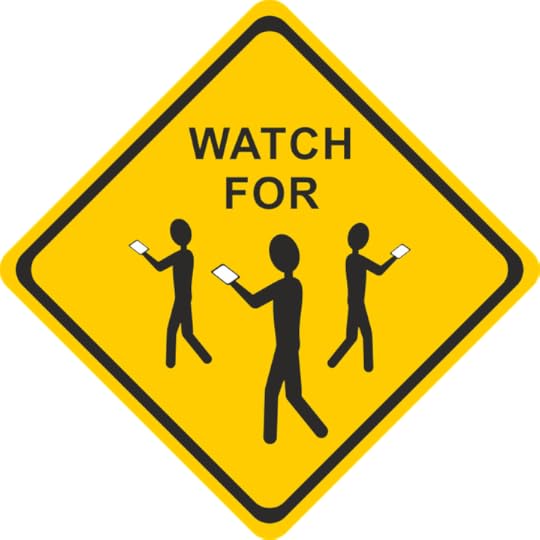 Shield by Succo. CC0 public Domain via Pixabay.
Shield by Succo. CC0 public Domain via Pixabay.While these technologies can be beneficial in a wide variety of environments, its use enables distraction and attenuates attention. Two recent case reports are among the first in the medical literature of augmented-reality application-related injuries requiring acute intervention in a trauma center. The first incident involved four passengers in a single vehicle rollover accident, in which the driver, a 19-year-old male was “hunting Pokémon” while driving and found one across the road. In an attempt to “flick his Pokémon ball to capture the Pokémon”, he lost control of his vehicle, rolling it, and ejecting the three other passengers from the bed of the pickup. Luckily a CT scan of the head identified only a small focus of subarachnoid hemorrhage with no evidence of increased intracranial pressure and a Glasgow coma scale of 15, as well as a small laceration of the liver involving the caudate lobe. The second incident was caused indirectly by a Pokémon Go user, as a driver swerved off the road to avoid the distracted pedestrian player. The driver was a 58-year-old woman who presented to the emergency department with multiple pelvic fractures that were treated non-operatively. Two other potentially dangerous scenarios may arise in which distracted users either directly cause injury to non-users (i.e. an accident involving a distracted driver and a pedestrian), or where a non-user may inadvertently injure a distracted user (i.e. an alert driver unable to stop in time when a distracted user rushes out onto a busy street).
Five years ago, only one in three Americans owned a smartphone, and that number has since doubled. Now 46% of all smartphone users say their device is something they “cannot live without.” These applications and mobile devices improve our lives, yet the potential to be consumed by their never-ending distractions might outweigh their benefits, at least until we maintain a digital equilibrium between work and play. Further research is yet to be done on what measures can be taken to ensure the safety of mobile augmented reality applications that promote ambulatory activity and to prevent distraction-related morbidities. Likewise, proper precautions and preparation must be taken by responsible users of augmented reality to minimize distractions and prevent such potentially pervasive perils from becoming a public health risk. As scientists and clinicians, we must properly “dose” the use of these devices, “dose” activity, and “dose” recreation without succumbing to a potentially fatal “overdose” of distraction.
Feature image: Pokémon Go by Tumisu. CC0 Public Domain via Pixabay.
The post Dosing distraction in the world of augmented-reality appeared first on OUPblog.

Making Connections at #OHA2016
In the words of our very own Troy Reeves, the OHA Annual Meeting offers a “yearly dose of sanity.” Whether you’re reading this while waiting for one of the panels to start, sitting this one out, or reflecting back on the excitement of the meeting later, we want to bring you a little taste of the fun. Below you can hear from a handful of oral historians on why they love the OHA Annual Meeting, as well as a look at social media activity during the conference. Follow along with live updates from our man-on-the-ground, Mark Garcia on Twitter and Facebook.
Why do Teresa Bergen and Jeff Corrigan love the annual meeting? Because of the connections!
“As a transcriptionist, I treasure the opportunity to contribute to the greater communal effort to preserve history — especially the voices of ordinary people. The OHA is composed of members with that same mission. Going to the annual meeting gives me the chance to connect with them and learn about their current projects. I’m especially interested in the ways that oral historians get their interviews out of the scholarly archives and into the ears of the general public.”
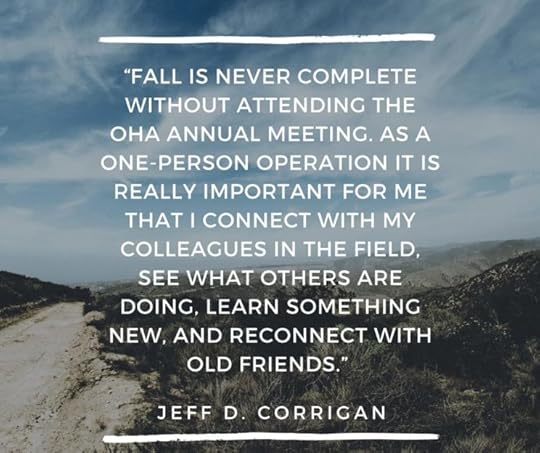
Troy Reeves and Allison Tracey see the annual meeting as a way of getting pumped up to continue doing the hard work of oral history every year.
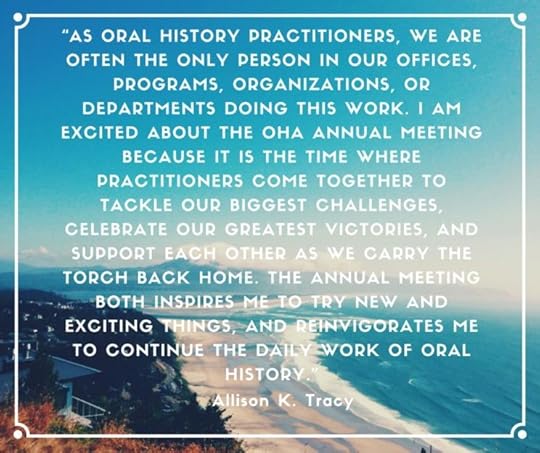
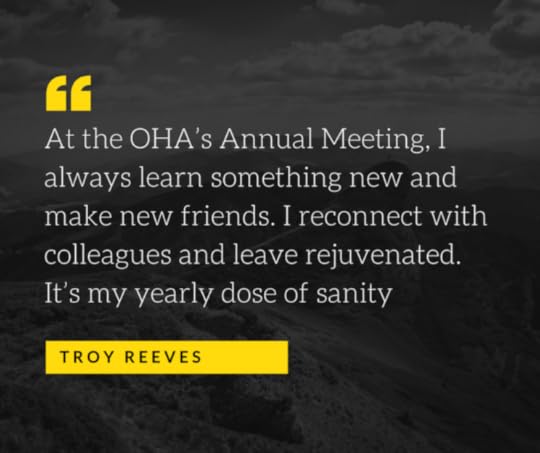
For Christian Lopez, the annual meeting is all about sharing, and coming together to move forward.
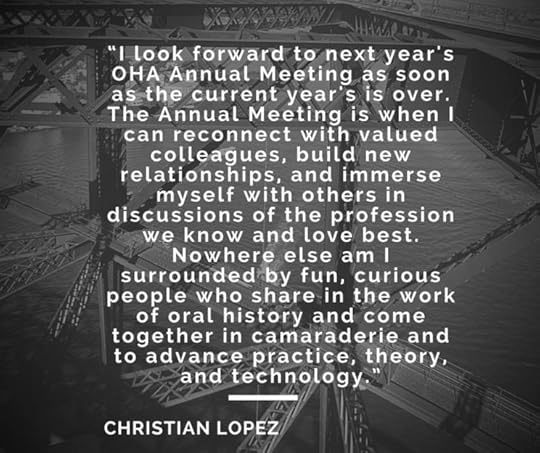
The Annual Meeting is great for building connections, but so is oral history broadly. It’s all about bringing together the past and the present in unique and interesting ways.
“I love oral history because it unveils the hidden treasures of times past—those nuggets packed away in people’s memories, in their remembrances—and then layers them with beliefs, feelings, and perspectives so hard to capture in the written word.”
“I love oral history because it makes me feel more intimately connected with voices from the past.”
Andrew Shaffer (that’s me!)
Make sure to follow us on Twitter, Facebook, Tumblr, or Google+, or take a look back at the excitement from years past with our recaps of the 2014 Annual Meeting and a look at the top #TwitterDebates from last year.
The post Making Connections at #OHA2016 appeared first on OUPblog.

October 13, 2016
Will print die?: When the inevitable isn’t
Mark Twain is reputed to have quipped, “Reports of my death have been greatly exaggerated.” Such hyperbole aptly applies to predictions that digital reading will soon triumph over print.
In late 2012, Ben Horowitz (co-founder of Andreessen Horowitz Venture Capital) declared, “Babies born today will probably never read anything in print.” Now four years on, the plausibility of his forecast has already faded.
It’s understandable why Horowitz spoke so boldly in 2012. Since the 1980s, a growing number of us have been reading on digital screens, and an initial round of eReaders such as Sony’s Librié and Gemstar’s Rocket eBook Reader captured the fancy of some early adopters in the late 1990s and early 2000s. But late 2007 marked a watershed.
The coming of the Amazon Kindle – with inexpensive eBooks to read on it – launched a sales tsunami that shook up the publishing world. During the next five years, triple-digit growth for electronic books was to become the new normal, driven both by the enticement of novelty and a cluster of mega-sellers such as Fifty Shades of Grey, Hunger Games, and Divergent. Figures for print paled in comparison.
But then the wave crested. For the first half of 2013, sales of children’s and young adult eBooks plunged 46% from the previous year-to-date. The Association of American Publishers reported that by year’s end, overall eBook sales for 2013 had risen only 3.8%.
A bevy of factors have contributed to the growth of eReading. Digital books are convenient to carry around, and they generally cost less than their print cousins. With massive increases in online education, it’s not surprising that most course materials assigned for these classes are electronic. It’s also hip to be reading eBooks.
One group that cares intensely about convenience, saving money, and moving with the “in” crowd is young adults. Are they die-hard fans of e Reading? I decided to ask.
Between 2013 and 2015, I surveyed 429 university students from five countries (the US, Japan, Germany, Slovakia, and India) about their reading patterns and preferences regarding print versus digital screens. The results surprised me. Those same students who might be texting or buying shoes online while faculty are lecturing had much praise for old-fashioned print. A whooping 92 % said they concentrated best when reading in print, and 87% judged that if cost were the same as for digital, they would prefer using print for their school work. (Four out of five expressed the same choice for print when it came to pleasure reading.)
 “Kindle” by John Blyberg. CC BY 2.0 via Flickr
“Kindle” by John Blyberg. CC BY 2.0 via FlickrWhat about younger readers? The publisher Scholastic conducts bi-annual surveys of kids ages 6-17. In their most recent iteration (data collected in Fall 2014), Scholastic found that 71% of 12-14 year-olds agreed with the statement “I’ll always want to read books printed on paper even though there are eBooks available.” This number compares with only 54% who agreed in the 2012 survey.
It’s easy to be fooled into thinking that young readers strongly gravitate to digital reading, given all the time they spend on social media or playing Pokémon GO. However, as the mother of a 9 year-old in the Scholastic study commented, “I assumed my daughter would like eBooks better because she is always on her tablet, but she still prefers print.”
Reports from publishers are confirming these user patterns. eBook sales are dipping in both the US and the UK. For those in the academic world, another preference indicator is what university faculty say about their research practices. A recent survey reported that when faculty wanted to read a scholarly monograph cover to cover, almost 80% indicated it was easier to do so with print. About two-thirds expressed the same preference when reading a section of a book in depth.
According to the old adage, “It ain’t over till the fat lady sings.” While the phrase may have originally referenced opera, it works well in thinking about the future of the written word. In 2006, no one could have foreseen the astounding development of eReaders and eBooks. (Fifty years earlier, no one anticipated personal computers or Google.) These days, there is much talk about a “both-and” world: some digital reading, some print. A growing number of publishers and distributors are bundling eBooks together with print, at only a small additional cost.
The printed word has been with us in the West for more than 500 years. These days, it’s not the only successful technology for digesting – or producing – text. To wit: Barack Obama’s reading habits. A recent piece in the New York Times described the solitary hours he spends working after dinner. Obama reads briefing papers in hard copy but skims newspapers on his iPad. (He does an incredible amount of writing in longhand, but I’ll bet he also knows how to type.)
So far at least, the jury remains out on the future mix of print and digital media. My bet is that for some time to come, readers will have the chance to follow their own preferences.
The fat lady has not yet sung.
Featured Image Credit: “Diving into Digital Books 4” by Jennifer LaGarde. CC BY-SA 2.0 via Flickr.
The post Will print die?: When the inevitable isn’t appeared first on OUPblog.

Oxford University Press's Blog
- Oxford University Press's profile
- 238 followers



